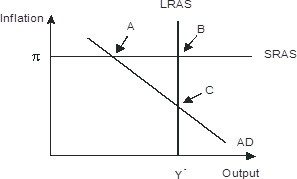Behavioral economists use which technique to test economic theory?
A) controlled experiments
B) price theory
C) environmental economics
D) lie detector tests
A
You might also like to view...
Refer to the figure below. In response to gradually falling inflation, this economy will eventually move from its short-run equilibrium to its long-run equilibrium. Graphically, this would be seen as
A. long-run aggregate supply shifting leftward B. Short-run aggregate supply shifting downward C. Aggregate demand shifting rightward D. Aggregate demand shifting leftward
Which of the following most accurately describes the behavior of the U.S. economy during the 2001 recession?
A) Aggregate demand fell as business investment declined while aggregate supply rose as a result of continued productivity growth. B) Aggregate demand fell primarily as a result of reduced consumption while aggregate supply increased due to continued growth in productivity. C) Aggregate demand fell due to a reduction in business investment while aggregate supply declined due to a reduction in productivity. D) Aggregate demand fell due to the bursting of the housing bubble while aggregate supply fell due to slower productivity growth.
Between 1870 and 1920, the total labor force increased by threefold while
(a) the total number of people employed in agriculture increased by almost twofold and the total number of people employed in manufacturing and other non- agriculture increased fivefold. (b) the total number of people employed in agriculture increased by almost fivefold and the total number of people employed in manufacturing and other non- agriculture increased by threefold. (c) the total number of people employed in agriculture increased and the total number of people employed in manufacturing and other non- agriculture increased by threefold. (d) the total number of people employed in manufacturing and other non- agriculture increased fivefold while agriculture decreased by twofold.
Labor specialization can increase production primarily because workers
a. are now supervised more and so have to work harder b. become proficient when they specialize in what they do best c. have to work more hours to buy the things they want d. engage in competitive, rather than cooperative, production e. have to learn how to do every production-related task well